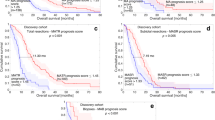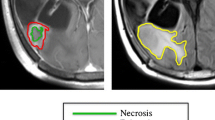Abstract
Automatic survival prognosis in glioblastoma (GBM) could result in improved treatment planning for the patient. The purpose of this research is to investigate the association of survival in GBM patients with tumor features in pre-operative magnetic resonance (MR) images assessed using a fully automatic computer algorithm. MR imaging data for 68 patients from two US institutions were used in this study. The images were obtained from the Cancer Imaging Archive. A fully automatic computer vision algorithm was applied to segment the images and extract eight imaging features from the MRI studies. The features included tumor side, proportion of enhancing tumor, proportion of necrosis, T1/FLAIR ratio, major axis length, minor axis length, tumor volume, and thickness of enhancing margin. We constructed a multivariate Cox proportional hazards regression model and used a likelihood ratio test to establish whether the imaging features are prognostic of survival. We also evaluated the individual prognostic value of each feature through multivariate analysis using the multivariate Cox model and univariate analysis using univariate Cox models for each feature. We found that the automatically extracted imaging features were predictive of survival (p = 0.031). Multivariate analysis of individual features showed that two individual features were predictive of survival: proportion of enhancing tumor (p = 0.013), and major axis length (p = 0.026). Univariate analysis indicated the same two features as significant (p = 0.021, and p = 0.017 respectively). We conclude that computer-extracted MR imaging features can be used for survival prognosis in GBM patients.



Similar content being viewed by others
References
Dolecek TA, Propp JM, Stroup NE, Kruchko C (2012) CBTRUS statistical report: primary brain and central nervous system tumors diagnosed in the United States in 2005–2009. Neuro-Oncology 14(suppl 5):v1–v49
Stupp R, Hegi ME, Mason WP et al (2009) Effects of radiotherapy with concomitant and adjuvant temozolomide versus radiotherapy alone on survival in glioblastoma in a randomised phase III study: 5-year analysis of the EORTC-NCIC trial. Lancet Oncol 10(5):459–466
Stupp R, Mason WP, Van Den Bent MJ et al (2005) Radiotherapy plus concomitant and adjuvant temozolomide for glioblastoma. N Engl J Med 352(10):987–996
Lacroix M, Abi-Said D, Fourney DR et al (2001) A multivariate analysis of 416 patients with glioblastoma multiforme: prognosis, extent of resection, and survival. J Neurosurg 95(2):190–198
Park JK, Hodges T, Arko L et al (2010) Scale to predict survival after surgery for recurrent glioblastoma multiforme. J Clin Oncol 28(24):3838–3843
McDonald KL, Aw G, Kleihues P (2012) Role of biomarkers in the clinical management of glioblastomas: what are the barriers and how can we overcome them?, Front Neurol, 3
Verhaak RG, Hoadley KA, Purdom E et al (2010) An integrated genomic analysis identifies clinically relevant subtypes of glioblastoma characterized by abnormalities in PDGFRA, IDH1, EGFR and NF1. Cancer Cell 17(1):98
Colman H, Zhang L, Sulman EP et al (2010) A multigene predictor of outcome in glioblastoma. Neuro-oncology 12(1):49–57
Yan H, Parsons DW, Jin G et al (2009) IDH1 and IDH2 mutations in gliomas. N Engl J Med 360(8):765–773
Gorlia T, van den Bent MJ, Hegi ME et al (2008) Nomograms for predicting survival of patients with newly diagnosed glioblastoma: prognostic factor analysis of EORTC and NCIC trial 26981-22981/CE. 3. Lancet Oncol 9(1):29–38
Rivera AL, Pelloski CE, Gilbert MR et al (2010) MGMT promoter methylation is predictive of response to radiotherapy and prognostic in the absence of adjuvant alkylating chemotherapy for glioblastoma. Neuro-oncology 12(2):116–121
Minniti G, Salvati M, Arcella A et al (2011) Correlation between O6-methylguanine-DNA methyltransferase and survival in elderly patients with glioblastoma treated with radiotherapy plus concomitant and adjuvant temozolomide. J Neurooncol 102(2):311–316
Pope WB, Sayre J, Perlina A, Villablanca JP, Mischel PS, Cloughesy TF (2005) MR imaging correlates of survival in patients with high-grade gliomas. Am j neuroradiol 26(10):2466–2474
Zinn PO, Sathyan P, Mahajan B et al (2012) A novel volume-age-KPS (VAK) glioblastoma classification identifies a prognostic cognate microRNA-gene signature. PLoS One 7(8):e41522
Gutman DA, Cooper LA, Hwang SN et al (2013) MR imaging predictors of molecular profile and survival: multi-institutional study of the TCGA glioblastoma data set. Radiology 267(2):560–569
Mazurowski MA, Desjardins A, Malof JM (2013) Imaging descriptors improve the predictive power of survival models for glioblastoma patients. Neuro-oncology 15(10):1389–1394
Zacharaki E, Morita N, Bhatt P, O’Rourke D, Melhem E, Davatzikos C (2012) Survival analysis of patients with high-grade gliomas based on data mining of imaging variables. Am J Neuroradiol 33(6):1065–1071
Zhou M, Hall LO, Goldgof DB, Gillies RJ, Gatenby RA (2013) Survival time prediction of patients with glioblastoma multiforme tumors using spatial distance measurement. SPIE Med Imaging: Int Soc Opt Photonics, p. 86702O-O-7
Popuri K, Cobzas D, Murtha A, Jägersand M (2012) 3D variational brain tumor segmentation using Dirichlet priors on a clustered feature set. Int J Comput Assist Radiol Surg 7(4):493–506
Zhu Y, Young GS, Xue Z et al (2012) Semi-automatic segmentation software for quantitative clinical brain glioblastoma evaluation. Acad Radiol 19(8):977–985
Zikic D, Glocker B, Konukoglu E, et al. (2012) Decision forests for tissue-specific segmentation of high-grade gliomas in multi-channel MR. Medical Image Computing and Computer-Assisted Intervention–MICCAI 2012, Berlin: Springer, pp 369–376
Zhang J, Barboriak DP, Hobbs H, Mazurowski MA (2013) A fully automatic extraction of magnetic resonance image features in Glioblastoma patients. Med Phys 41(4):042301
Conflict of interest
Dr. Maciej A. Mazurowski receives grant funding from the Department of Defense Breast Cancer Research Program. He also receives consulting fees from American College of Radiology Image Metrix (contractor to GE) for his services as a scientific consultant. Jing Zhang, Katherine B. Peters, and Hasan Hobbs have no conflicts of interest to declare.
Author information
Authors and Affiliations
Corresponding author
Rights and permissions
About this article
Cite this article
Mazurowski, M.A., Zhang, J., Peters, K.B. et al. Computer-extracted MR imaging features are associated with survival in glioblastoma patients. J Neurooncol 120, 483–488 (2014). https://doi.org/10.1007/s11060-014-1580-5
Received:
Accepted:
Published:
Issue Date:
DOI: https://doi.org/10.1007/s11060-014-1580-5




